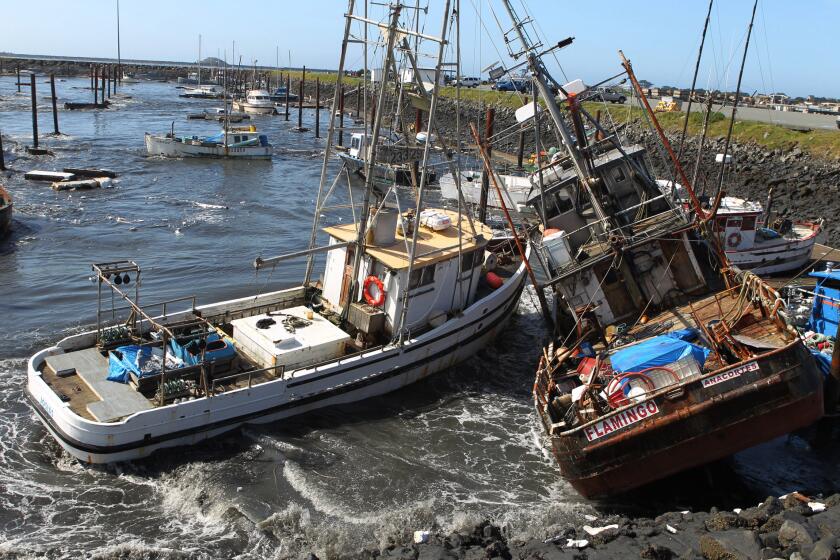Vintage Vibrations
- Share via
RICHMOND, Calif. — When the next big one hits, for God’s sake, let’s be sure to save the wine.
This is California, after all, the state that produces 90% of the nation’s wine--its merlot, white zinfandel and sauvignon blanc.
And so winemakers from across the region gave rapt attention to a test by UC Berkeley researchers last week that subjected a towering stack of oaken barrels to a simulated earthquake to test how California wine cellars might hold up in the next major temblor.
The results were more than a little rattling.
Experts say many of the state’s 847 commercial wineries--in the Napa and Sonoma valleys, along the Mendocino coast and in Santa Barbara County--are within 30 miles of a major fault.
Still, some winemakers are in denial over the possible havoc and loss of life that a quake could wreak in claustrophobic wine cellars, they say.
Using one of the nation’s largest quake simulators--a device called a shake table--researchers at UC Berkeley’s Pacific Earthquake Engineering Research Center on Friday subjected barrels stacked six high to a series of jolts that simulated a magnitude 7.4 quake like the one that rocked Iran in 1978.
As a crowd of 100 gasped, the massive concrete table began an earthquake’s signature back-forth-and-sideways motion, making the tower wobble. Within seconds, the stack of 12 barrels, weighing 600 pounds each and strapped two across to a vertical bar as a safety precaution, toppled forward.
But rather than bounce to the floor and split open, spilling their contents, the barrels swung from their straps and harmlessly knocked together.
Like a prize fight that ends with a first-round knockout punch, the event was over almost before it began--leaving winemakers oohing and ahing and the graduate student behind the experiment beaming with satisfaction.
“It’s exactly what I expected,” said Joshua Marrow, a 25-year-old earthquake engineering student. “It didn’t stay up for long. A few wobbles and then down it went.”
Marrow conceded that his test conditions were far from the real earthquake McCoy. For one thing, the university’s shake table can shift only 5 inches in either direction and does not thrust up or down.
In the Iranian quake, the earth heaved violently upward, and the ground moved six feet along the fault line. Also, Marrow said with a smile, his barrels were filled with water, not wine.
Still, he said, the experiment and future months of data crunching could serve as a wake-up call to wineries that the present portable steel rack storage system might need some engineering.
“The industry has been using the present stacking system for 20 years and over that time the product stored has grown exponentially. Still, this is the first time that it’s ever really been tested,” Marrow said. “We’re just providing some food for thought here.”
Indeed, California wine is a more than $33-billion-a-year business. Last year, the state’s wineries provided 446 million gallons to customers, domestic and foreign.
If California were a nation, it would be the fourth leading wine-producing country in the world, behind France, Italy and Spain.
State winemakers donated $100,000 to fund Marrow’s study, but experts say the industry needs to take earthquakes more seriously.
Don Neel, publisher of Practical Winery and Vineyard in San Rafael, said the 1989 Loma Prieta quake showed winemakers that temblors can spill a year’s harvest.
“What this experiment has shown us is not just a curiosity,” he said. “Because the next quake is not a question of if; it’s when. Still, so much of this industry has their heads in the sand.”
Evelyn Heraty, an assistant winemaker at the Clois du Bois winery in Geyserville, said the demonstration opened her eyes. “We need to look into this,” she said. “It’s not just about the product. We owe it to the safety of our employees.”
Marrow said his three-year experiment is part of a growing emphasis in earthquake engineering that looks beyond protecting structures to their contents.
The Japanese, he said, have done similar tests on their system for storing casks of sake. And there are other domestic applications, such as the cavernous storage areas of major chain warehouse stores.
But he said his study has struck upon the perfect blend of the California experience: wine and earthquakes.
“Everybody drinks wine,” he said. “And we’re all watching out for the next earthquake.”
More to Read
Sign up for Essential California
The most important California stories and recommendations in your inbox every morning.
You may occasionally receive promotional content from the Los Angeles Times.











